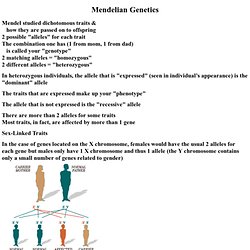

Genetics Practice Problems. Genetics Practice Problems You may type in your own answers, then check to see if you were right.

If you’re totally stumped, you can tell the computer to show you the answer to a particular question. Monohybrid Cross: In humans, brown eyes (B) are dominant over blue (b)*. A brown-eyed man marries a blue-eyed woman and they have three children, two of whom are brown-eyed and one of whom is blue-eyed. (* Actually, the situation is complicated by the fact that there is more than one gene involved in eye color, but for this example, we’ll consider only this one gene.) Testcross: In dogs, there is an hereditary deafness caused by a recessive gene, “d.”
Incomplete Dominance: Note: at least one textbook I’ve seen also uses this as an example of pleiotropy (one gene – multiple effects), though to my mind, the malaria part of this is not a direct “effect” of the gene. A photo, taken by Dr. Dihybrid Cross: If the man is both Rr and Tt (How do we know that?) Multiple Alleles and Codominance: Ms. Epistasis: Punnett square Examples [Athro, Limited: Genetics] Genetic traits. Mendel studied dichotomous traits & how they are passed on to offspring2 possible "alleles" for each traitThe combination one has (1 from mom, 1 from dad) is called your "genotype"2 matching alleles = "homozygous"2 different alleles = "heterozygous" In heterozygous individuals, the allele that is "expressed" (seen in individual’s appearance) is the "dominant" allele The traits that are expressed make up your "phenotype" The allele that is not expressed is the "recessive" allele There are more than 2 alleles for some traitsMost traits, in fact, are affected by more than 1 gene Sex-Linked Traits In the case of genes located on the X chromosome, females would have the usual 2 alleles for each gene but males only have 1 X chromosome and thus 1 allele (the Y chromosome contains only a small number of genes related to gender) in your Family or Future Family Earlobes: Free ear lobes (dominant trait) vs.

Forelock: White forelock (dominant trait) vs. Dimples: Dimples (dominant trait) vs. Dominant & Recessive Genes. Dominant vs. Recessive Traits. As of July 1, 2013 ThinkQuest has been discontinued.

We would like to thank everyone for being a part of the ThinkQuest global community: Students - For your limitless creativity and innovation, which inspires us all. Teachers - For your passion in guiding students on their quest. Partners - For your unwavering support and evangelism. Parents - For supporting the use of technology not only as an instrument of learning, but as a means of creating knowledge. We encourage everyone to continue to “Think, Create and Collaborate,” unleashing the power of technology to teach, share, and inspire.
Best wishes, The Oracle Education Foundation. Genes : Bill Nye on Genes (Part 1/3) Genetics 101 Part 1: What are genes? Life Science.